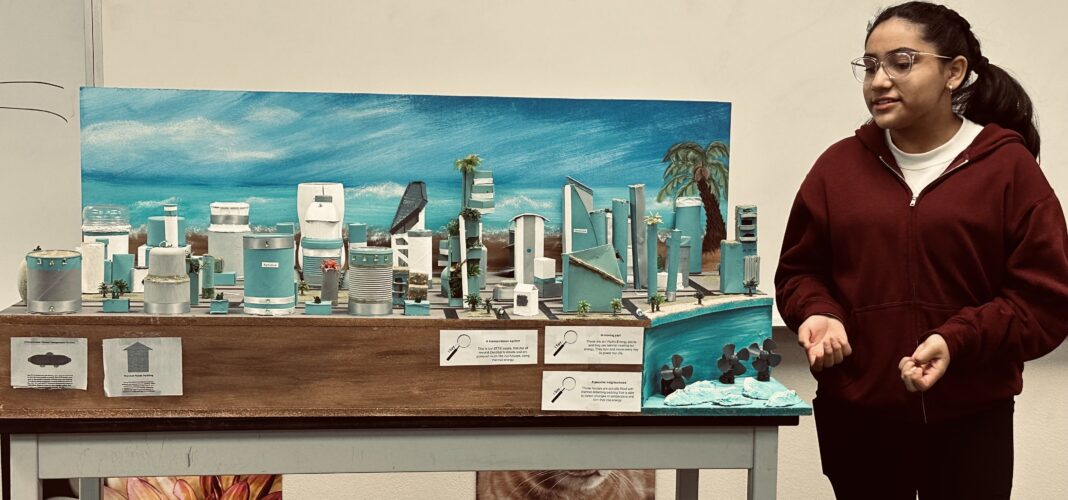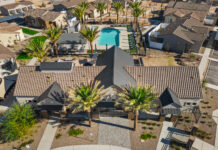It was something I had never experienced: Judging middle school students and their science projects.
Maricopa middle school students in the blended-learning program creatively and at times dramatically teamed up to present their Future Cities Showcase projects Thursday night at Desert Wind Middle School.
They imagined and designed model cities a century into the future that were 100% powered by green, clean and renewable energy sources. The projects were made of recycled materials, including toilet paper rolls for cylindrical objects, which I joked about but don’t think my fellow judges appreciated.
The teams talked about imaginary cities such as New Dresden, Oriac, Zanzibar, Big Bill, Lucero, Crothelpdoun and Gadamascar (the redeveloped part of Madagascar, of course).
Since I consider myself somewhat of an environmentalist who owns a solar-powered home and drives an electric vehicle, I am quite open to alternative energy sources. I love to read and learn about green energy, especially as it applies to transportation.
Students displayed their cities in Desert Wind’s hallways so parents, teachers and community members could see the projects up close and ask student team members questions. It was fun to listen to their deeply thought out (some not so much) concepts that teams brainstormed over for hours and hours.
As a member of a judging team, I evaluated seven student presentations that described imaginary designs, some established by existing science such as solar, hydro, tidal and geothermal power.
Some were intriguing, expressing the possibilities of solar-powered monorails using magnetic-levitation rail technology, a viable concept the U.S. rail system has all but ignored.
Others were a bit far-fetched, such as “fish power,” the extraction of energy from fish scales, and power from humidity. Huh? Still trying to figure that out. Nonetheless, it was fun to hear them and consider the possibilities.
At times, I tried hard to remain open-minded regardless of a student’s wild fantasy. But in the end, it was refreshing to hear students show off a project in which they had meticulously invested much time and hard work.
My favorite presentation came from a “competitive” team of older middle-schoolers. They called their future city Lucero, and their presentation included the character of Ben Franklin as the fabled discoverer of electricity, who magically appears with his “lightning rod” kite and key in hand, which he flew to attract “electric fire.”
Franklin, in comic fashion, asked teammates how they came up with the concept of Lucero, which is primarily powered by lightning in a part of the world known to have the highest number of lightning strikes. Excess power generated is stored in large-scale batteries to compensate for days of fewer lightning strikes.
But knowing that their primary source is dependent on the weather, the team cited two backup sources of energy, biomass and hydo-electricity.
Biomass is power generated by the burning of organic waste materials. Hydropower uses moving water to generate electricity.
Even though some of the teams lacked the research and homework to logically think their projects through, I had to credit them for standing up in front of an audience and reciting the scripts they had written. It’s not easy and I felt the pain of some students who were almost petrified with fear and barely able to eke out a complete sentence. In the end, I thought, it’s better to get them out from behind their digital devices and speaking to real people face-to-face.
My team of judges included Desert Sunrise High School student Beckett Butters, Desert Wind Middle School sixth-grade teacher Louie Oceja and Maricopa City Councilman Bob Marsh.
Oceja, a Philippine national on a U.S. work visa, said it was his last year of teaching at the Desert Wind. He must now return to his homeland after five years stateside.
He told me he missed his family there, although he will also miss teaching in Maricopa.
As judges we questioned teams about their projects and carefully scored on a level of 1 to 6, using a rubric of judging categories.
There was a good cross-section of elected officials as judges, including Maricopa Unified School District Government Board members, who always donate huge amounts of their free time to benefit local education.
Winners of the Future Cities competition in Maricopa will move on to state competitions at Arizona State University. They’ll be announced soon in InMaricopa, too.







![City gave new manager big low-interest home loan City Manager Ben Bitter speaks during a Chamber of Commerce event at Global Water Resources on April 11, 2024. Bitter discussed the current state of economic development in Maricopa, as well as hinting at lowering property tax rates again. [Monica D. Spencer]](https://www.inmaricopa.com/wp-content/uploads/2024/04/spencer-041124-ben-bitter-chamber-property-taxes-web-218x150.jpg)

![3 things to know about the new city budget Vice Mayor Amber Liermann and Councilmember Eric Goettl review parts of the city's 2024 operational budget with Mayor Nancy Smith on April 24, 2024. [Monica D. Spencer]](https://www.inmaricopa.com/wp-content/uploads/2024/04/spencer-042424-preliminary-budget-meeting-web-218x150.jpg)


![Alleged car thief released without charges Phoenix police stop a stolen vehicle on April 20, 2024. [Facebook]](https://www.inmaricopa.com/wp-content/uploads/2024/04/IMG_5040-218x150.jpg)





